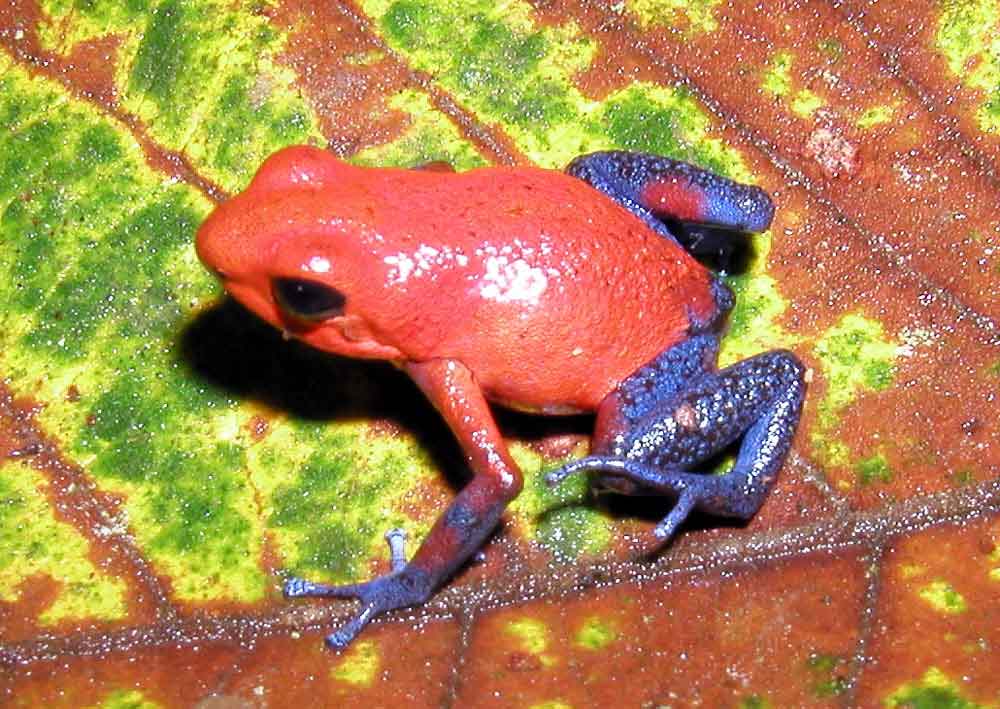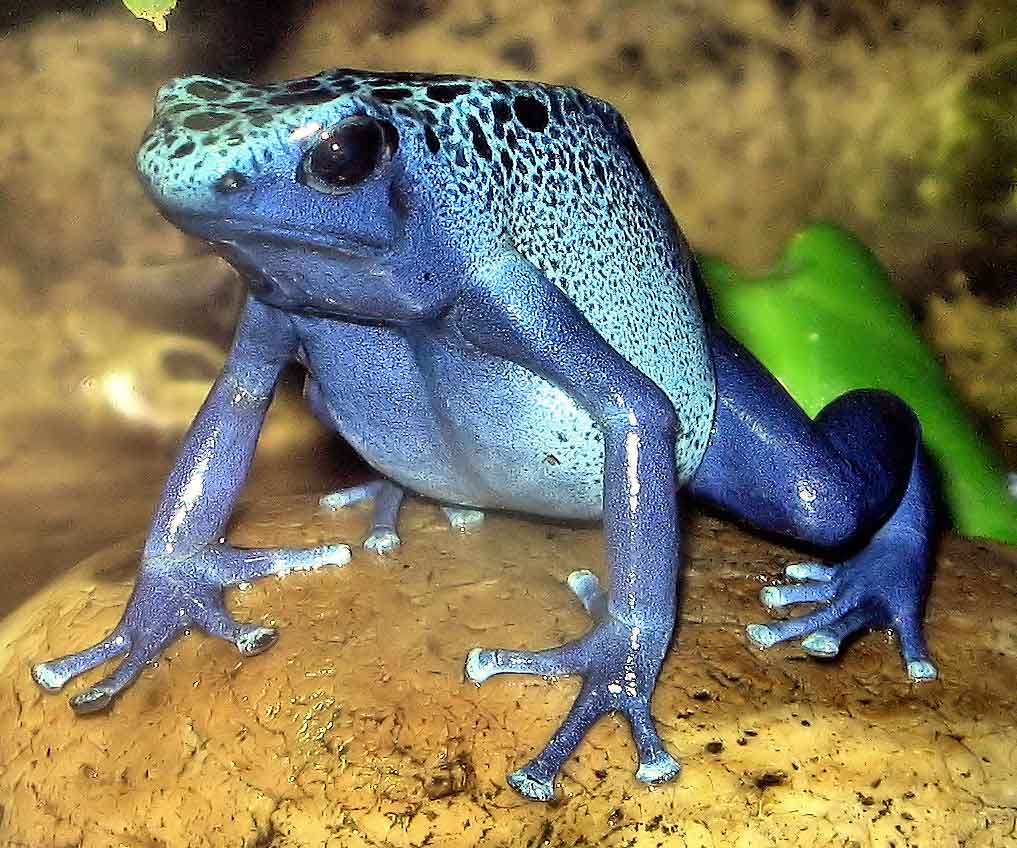
Content |
|---|
The “tree climbing frog” or Poison dart frog (Dendrobatidae) lives mainly in the rainforests of South and Central America. Due to its colorful, their diurnal lifestyle and their interesting reproductive strategy -the parents take care of their offspring-, many species are very popular and are regularly bred in local forms of various colors.
Some popular species are, for example, the Dyeing poison dart frog (Dendrobates tinctorius), the Green and black poison dart frog (Dendrobates auratus), the Yellow-banded poison dart frog (Dendrobates leucomelas), as well as the Anthony's poison arrow frog (Epipedobates anthonyi), the terrible Golden poison frog (Phyllobates terribilis) and Strawberry poison-dart frog (Oophaga pumilio).
Many other species of different genera can be found as offspring in trade.
Sex differences
It is not easy to distinguish the sexes from the Poison dart frog. Females tend to be larger, stronger build and with sticky discs on fingers smaller than males. Males who are ready to mate make a trill.
Behavior
The Poison dart frog can raise itself, as a couple or in a group. The association of several species is usually not problematic in sufficiently large terrariums. Males occupy small territories.
Terrarium

A terrarium for climbing frogs must have some special features: The Calls “terrariums for the species Dendrobatidae” have fine mesh ventilation surfaces (Drosophila hermetic), as well as a gasket between the sliding panes to prevent very small food animals from escaping, like fruit flies, isopods and springtails. The sloping front windows and generously dimensioned ventilation zones prevent the windows from fogging up in high humidity and, together with a drain integrated in the lower glass, help to avoid dangerous flooding.
The terrarium must measure at least 60 x 40 x 50 cm. (length x widht x hight) for a group of maximum 6 animals of the smallest species (until 4 body length cm), for the largest species at least 80 x 40 x 60 cm. (length x widht x hight) for a maximum of 6 specimens.
Fluorescent tubes with a daily light duration of 10 to 12 hours are suitable for lighting. A UV component can have a positive effect on animal welfare. Because the areas of origin are very different, it is important to create the right temperature conditions for each species; for example, highland species do not tolerate higher temperatures. The optimum for the mentioned species is a soil temperature between 24 and 26 °C, with local heating up to 28 °C. At night, the temperature should be reduced to about 23 °C. At night, the temperature should drop to about 23 °C. For the basic temperature, weak heating mats can be used, installed outside the terrarium. They can be used to heat the floor (at most one third of the soil surface!) or the walls. With the help of a thermocontroller, the heating mat can be specifically controlled to prevent overheating.
The humidity should be at least 80 % and sometimes it can reach almost 100 %. This can be achieved by frequently spraying the terrarium with warm water or using a sprinkler system.. Waterfalls or artificial streams, whose moving water provides high humidity, are also suitable. Precise thermometers and hygrometers are needed to measure temperature and humidity.
For the Poison dart frog, 2, preferably 3 sides of the terrarium should be covered with cork, coconut fiber boards or similar. climbing facilities, like the roots, the lianas, the branches, etc., have proven useful. Curved cork bark or halved coconut shells are popular hiding places.
A shallow bowl of water (or a watercourse) also part of the basic equipment. The soil in the terrarium is suitable as a substrate, coco substrate or moss, which should always be kept slightly moist. A drainage layer of expanded clay at the bottom prevents waterlogging. The natural plantation with ferns, perched plants (for example, bromeliads), as well as climbing and creeping plants (for example, hiedra or ficus climbers) creates additional climbing and retreat possibilities and ensures high and uniform humidity.
Nutrition
The Poison dart frog feeds on the smallest insects (live), to which sufficient quantities must be given each day. In addition to small insects or micro-hunters, fruit flies are especially suitable (Drosophila), bean beetles, springtails, etc. Regular administration of a mineral preparation ensures healthy bone growth.
Care
Food scraps and droppings should be removed daily. The water bowls should also be cleaned daily and filled with fresh water.
Animal health must be monitored daily. The most common health problems in tree frogs are softening of the bones, emaciation, balance disorders and skin disorders. The Poison dart frog is especially sensitive to stressors. In case of anomalies, an amphibian vet should be consulted.
Acclimatization and handling
Amphibians are animals of pure observation and should NOT be petted. In the first days in his new home, animals need adequate rest to get used to their new environment. If required, animals must not be caught by hand, but with the help of plastic boxes or similar.
Reproduction

The smallest species spawn mainly on the leaves of plants and trees.. The largest species (Dendrobates tinctorius and Dendrobates auratus) they also spawn in caves. Depending on the species, a spawn comprises between two and 35 eggs. Spawning is preceded by a courtship ritual that can last for hours. The female approaches the male and caresses his back with her front legs. Both then look for a suitable place to spawn. Spawning takes place, for example, on bromeliad leaves above the leaf axils or in the leaf axil itself. The insemination of the eggs by the male occurs externally immediately after their release. The clutches are usually guarded by the male. Some species regularly water their clutches by emptying the contents of their bladder over the eggs..
The poison frogs they are daytime, as their bright colors offer them protection during the day. So that your tadpoles are not at the mercy of predators in rivers and ponds, the tadpoles that hatch after 10 to 16 days of embryonic development are transferred on the back of the male to the smallest accumulations of water in the plants (phytotelmata), like the armpits of leaves filled with water. In some species (for example, the Ranitomeya imitator) this transfer is done individually, in others, eg Epipedobates tricolor, can involve the entire laying at the same time. They later carry their young to the ground in the same way.
Females of some species feed unfertilized proximity eggs to tadpoles until metamorphosis, in others the larvae feed on algae or insects that fall in the axils of the leaves. The development from tadpole to juvenile frog lasts between six and 14 weeks.
Special features
All climbing frogs are subject to species protection legislation and require confirmation of origin. The holder must also comply with the registration obligation (exception: Dendrobates auratus and Dendrobates azureus).
The climbing frogs are highly susceptible to deadly infection by the dangerous chytrid fungus. Before handling the terrarium, all objects must be disinfected and thin rubber gloves must be worn. Newly acquired animals must be kept in strict quarantine for several months.
Although the name of poison frogs is inaccurate, since only a few species can be dangerous to humans, all tree climbing frogs have skin secretions that can cause irritation when they come in contact with human skin. This is another reason why it is advisable to capture the animals only with the help of a small container..





